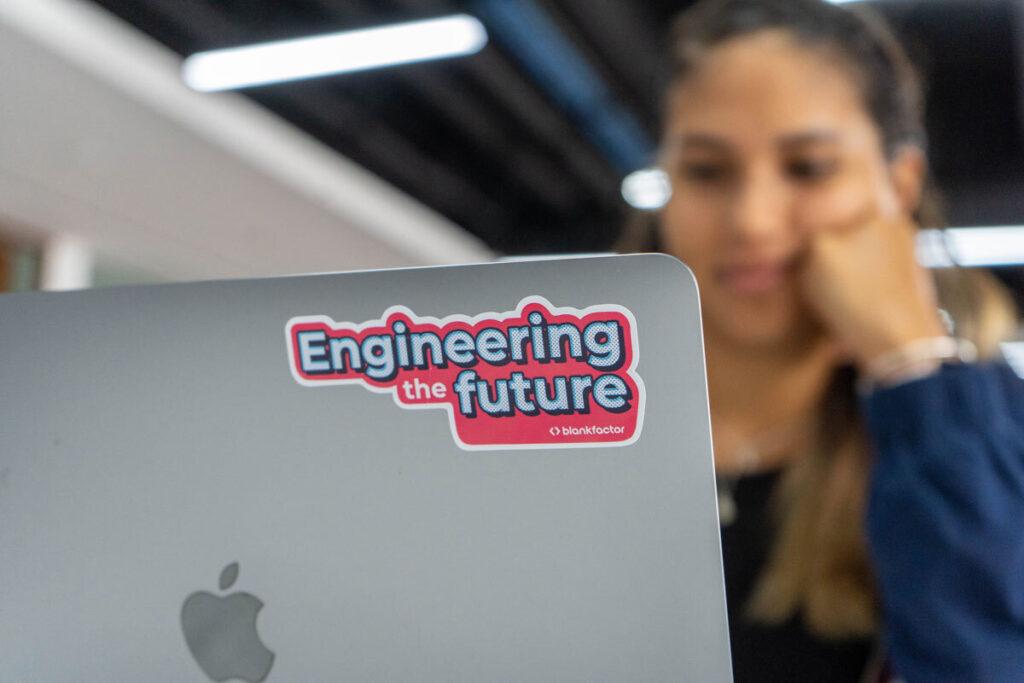Listen to the article
TL;DR: Blankfactor recently made it to the top 500 in Inc. 5000’s America’s fastest growing companies list. And we’re now following up on our growth with a description of our hiring and recruitment efforts by one of our Senior IT Recruiters. Find out how we go about our recruitment processes and how this ties in with our work culture as we continue to engineer the future, together.
We’re following up our most recent inclusion in Inc. 5000’s America’s fastest growing companies list to expand on just how we’re getting there. And, according to Statista, “IT professionals have become some of the most in-demand members of today’s labor force, as leading companies across industries continue to push for widespread adoptions of digital technologies.” The field is fierce. On this note, we’ll pause and elaborate on how we’re conducting our hiring and recruitment as part of our continued growth.
Being a part of the top 500 companies out of America’s already select list of 5000 of its fastest growing companies at a private level has placed us alongside companies like Oracle, Microsoft, and Facebook. A three-year revenue growth of over 300% stands as part of our great achievements as a company. Yet, we wouldn’t be anywhere without the valuable talent we’ve brought on board at a global level for that. And how do we manage to come in contact with leading talent across the globe?
A day-to-day description of our hiring and recruitment
There’s definitely a lot of dialing, voicemailing, and constant emailing getting us where we are. But, as day-to-day recruiters, our job goes far beyond establishing initial interviews. Growing means listening to our collaborators around the world.
In some offices, this practice has meant seeing parts of our team happily having lunch with us on their days off. For other locations, we’ve had to accept that transportation, long distances, and other factors make our teams prefer a work-from-home dynamic in the long run. In the end, as Hired has published when it comes to tech talent, “More than a quarter (29%) of candidates won’t consider commuting more than 30 minutes for a job and 65% are interested in working 100% remotely.” These statistics are indeed part of what we’re facing in our current working structures.
In this process, however we’ve needed to accommodate our dynamics has come from taking the time to group our members’ insight and preferences. Rather than imposing our initiatives and perspectives, we value the repercussions our decisions have on our teams’ daily lives. And we’re willing to adapt to more convenient agreements for all.
How we work across the globe
So far, we’ve extensively given a centric location with a nearby gym a try. Factoring our agreements with our landlords, including incentives with catering services or gaming providers are a result of this process. Yet, in spite of our efforts -and precisely because of them -, we ultimately and most certainly have come to the need of listening and communicating with our team members to adjust to global and local market needs in different ways.
We continue to sustain a modern building at one of our office locations, offering our talent child daycare, yoga sessions, a beauty salon, subsidized daily meals, a swimming pool, and more. In other parts of the world, we’ve needed to understand other needs get in the way of those experiences.
As we value our diverse cultural backgrounds, we also understand that, for as much as we’d like to take global measures that apply to all, we need to continue to nurture each culture for what it is at a local level. That implies continuing to foster the agreements to which people relate best wherever we are.
Localization that strives for a global understanding in hiring and recruitment
Our benefits and compensation packages are localized, yet also as standardized to our global offer as possible. For that, we take each location’s specific needs and characteristics into account and work hard at making the overall global packages as equitably as we can. These efforts of course always come with diverse challenges.
At the moment, we’re getting ready for big demands and needs in telecommunications and mobile, for example, according to the latest market trends. This has added an extra layer of challenge to our game plan, and we’re ready to excel at facing it. But that’s also why statistics and figures, research in general, are always a considerable part of the work we do in our background.
Especially from our national sources, we engage proactively with specific development entities wherever we’re located. In Costa Rica, for instance, we’ve come in contact with CINDE, the local development coalition initiative titled Coalición Costarricense de Iniciativas de Desarrollo (Costa Rican Coalition for Development Initiatives) to attain their latest data in terms of current workforce preferences, and more.
When hiring and recruitment is aimed at technological talent
Deciphering talent that’s focused in technology can be challenging. Some developers are true introverts while we also have extrovert leaders in our pool. It’s been an active question to nail just how to get to a middle ground in our company culture that works for all.
We recently created an engagement team within our Human Resources Department. Its purpose is to help us in our task of creating our team culture. And we invited different personalities in our developer stack to join our brainstorming sessions. With these efforts, we’re actively seeking to satisfy our talent and generate team bonding. And with that, we’ve identified an interest in gaming, virtual reality, and board games, for example.
Yet, we’ve also noted just how the biggest introverts are still interested in joining a community. They seem to just need a little push to be part of our collective activities to say it one way. We don’t seek to surprise our introverts with a direct approach and jump into a conversation with them out of the blue. On the contrary, we know we need to set up certain activities to get them to feel comfortable about interacting.

What happens when local talent works at a global level
We also take into account how our talent in a given location is part of other global teams aside from their local ones. Some of our team members might not even know people in their physical location. This is the case as they interact remotely with experts around the world for their daily tasks and areas.
Think about festivities and holidays in this sense. We take the opportunity the holidays give us to break the mold of what other companies are doing. We started thinking we may not celebrate local events as much as shared global affairs when thinking about important celebrations across the globe. But we ended up realizing we also have to value local cultures who enjoy celebrating their own independence day celebrations, for instance. We’re also enhancing their sense of belonging in the process. As a result, we can celebrate Halloween, Thanksgiving and the 4th of July as much as the different Latin American independence dates.
Another difference in our managed service provision model
In our managed service model, we actually stay away from hiring talent solely for a specific project. What we seek is to fulfill all of our leading tech needs by hiring talent in the precise areas in which we need their expertise – for the long-term. We’re building relationships in everything we do; from our clients and our talent to the locations in which we’re based.
Our screening processes for hiring and recruitment
To achieve all of the above, we’re actively connecting with attractive talent via LinkedIn and other platforms. Once we manage one of our valuable connections, we kindly offer our open positions to people of our interest. If the appeal is mutual, we move on to what we call a fun screening. This is our first interaction between recruiter and candidate just to get to know our candidates’ profile better.
From here, we either go into a technical interview followed by a decision-making process. Or, we can also go into technical testing that comes with a technical interview after it. Depending on the technology for which we’re hiring, we might engage in diverse types of skill testing. Back-end PHP technology is a great example of a specific skills test, which differs from our front-end one, for instance.
Letting talent work at their own pace, from the start
We give ample time frames for this skill answering for candidates to solve these tests with an open book or free resource methodology. And we always schedule these sessions at a day and time that’s most convenient for our candidates. They can take these from the comfort of their own place of choice. Also, our process is always remote. We only engage in physical presence onboarding as of their first day of employment. In this sense, the lead or supervisor to whom they respond will be the one assessing their results. This is tied to each office’s country manager, a highly-qualified lead who oversees the technological end of our staffing processes. These roles work independently from our Human Resource and Office managers, as well.
We all come together to form our valuable work culture
As noted, there’s considerable team work behind our current hiring and recruiting processes to generate everything we get to call Blankfactor’s service offer today. And we really have plenty of exciting news coming for everyone across the globe.
We still need to materialize our vision in many areas for an even greater end of the year to come. Yet, we’re already actively seeking to celebrate ordinary communal spaces in extraordinary ways. We’re scouting what other companies and our competition are doing simply to offer our talent a different or the same experience as it suits them best.
In doing so, we seek to stand out and be there for our talent in ways they can appreciate. This is our genuine differentiator for them for many years to come. And we certainly know this bears a repetitively positive outcome in how we service our clients. It’s all simply helping us build long-term relations with everyone involved.
Care to learn more about what we do?
Was this article insightful? Then don’t forget to look at other blog posts and follow us on LinkedIn, Twitter, Facebook, and Instagram.








